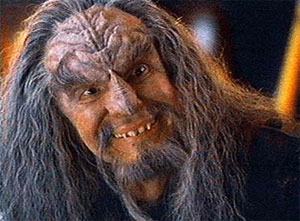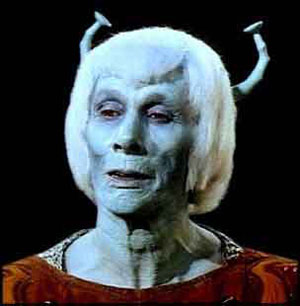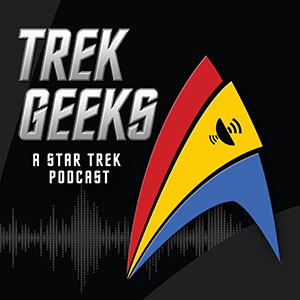Previously, science determined the implausibility of silicon- and ammonia-based life. Silicon is an element similar to carbon, which is why some astrobiologists consider it a candidate for the emergence of organisms; however, silicon compounds are limited to only a few stable molecular arrangements and crystals, so abiogenesis isn’t very probable.
Ammonia, on the other hand, has chemical and physical properties similar to water, though ammonia doesn’t promote the hydrophobic effect quite as strongly as water does, and, more importantly, stabilizing ammonia in the liquid state requires either (a) a below-zero global temperature or (b) an atmosphere nearly 12 thousand times as dense as Earth’s: the latter being difficult to find in the universe and the former hardly favoring the process of abiogenesis altogether.
But what of these strange new worlds, new life, and new civilizations so explored on Star Trek? Everything ranging from crystalline entities to Changelings, they appear to have such unique and exotic body plans that science couldn’t even begin to describe them or to determine how molecules could possibly compose sufficiently to generate these life forms. Indeed, they seem more fantasy than fact, and, unfortunately, there is a lot to biology that we still don’t understand, even of life on Earth.
We can hardly predict how life could emerge and evolve on exosolar planets; let alone how any alien could emerge from the abiogenesis of substances so unlike our own. That is why this article will discuss and speculate the different forms of life and their biology as presented on the shows. I present to you: the Strangers of the Cosmos.
Romulans and Vulcans
Romulans and Vulcans may be more plausible as water-based, carbon-based life forms on exosolar planets with Earthlike characteristics. Both breathe the same atmosphere, drink the same water, and even have nearly the same physical appearance as humans (minus the ears). There are also subtle differences: Vulcans are telepathic and Romulans are not, Romulans have head ridges and Vulcans do not, and one is a very warlike species while the other promotes peace.


As most Trekkers know, Romulans are descended from Vulcans over the course of millennia and both evolved into separate races. This is a classic example of reproductive isolation in the theory of evolution that gives rise to speciation. When a population in one area experiences an emigration (i.e. half the population leaves to a different locale) and the original population is now located in two different areas, the two populations are said to be reproductively isolated, meaning that they don’t interbreed simply because they hardly come into contact.
Over time, both populations will accrue enough random mutations that natural selection affects both groups differently, and so the two groups would adapt preferentially to their respective environments and be so genetically different from one another that they would be unable to interbreed; this is known as a speciation event, in which one group evolves from an original group into a new species. However, Romulans and Vulcans are perhaps easier to interbreed than say humans and Vulcans; in fact, it has been stated on the shows that Romulans and Vulcans are so physiologically similar that they can mate without any medical intervention. This leads me to believe that Romulans and Vulcans haven’t speciated and are perhaps members of the same species, though different cultures.
Romulans and Vulcans both have green blood. The color of blood is determined, at least on Earth, by the assimilation of transition metals in their oxygen-carrying proteins. For all mammals and avian species, blood is red because the oxygen carrier, hemoglobin, uses iron, a transition metal that appears reddish brown in solution. For the horseshoe crab, hemocyanin utilizes copper, which is blue. Vulcans and Romulans have green blood, which, if their oxygen-carriers are anything like hemoglobin or hemocyanin, may be an indication that their proteins utilize nickel to bind oxygen (or copper if their blood contained a high salt content). Nickel is another transition metal similar to iron and copper, except that it emits a green color in solution.
Klingons


Klingon head ridges are also a notable feature on the show. Not including The Original Series or the “Afflictions/Divergence” ark on Star Trek: Enterprise, almost all Klingons have head ridges, and many of them have different cranial patterns. The head ridges appear to be an exoskeletal extension of the Klingon’s spine over the cranium and ending just above the base of the nose. The head ridges were more pronounced and a lot broader in the Klingon’s evolutionary predecessor as shown in the TNG episode, “Genesis”; the purpose and function of the head ridges were likely to protect the Klingon from predators and enemies, a phenotype that may have had a greater advantage in some past when the Klingons were constantly hunting and competing for food and women.
Another observation I made about the head ridges is that they only seem to be similar in family units. For example, Worf, his borther Kurn, and his son Alexander all have similar cranial patterns obviously because the traits are heritable. But Worf’s head ridges by no means share the same resemblance with other Klingons’ ridges; in fact no two patterns are alike.
Just as humans have different appearances among different ethnicities (i.e. African, Asian, White, Latino), the Klingon head ridges may be an ethnic trend native to specific locales on Qo’nos, in which the frequency of a set of alleles that give rise to a particular cranial pattern is maintained by breeding within a population. Klingons with different head ridges may be a sign of a diverse culture.
In Star Trek VI: The Undiscovered Country, Klingon blood was shown to be pink in color, though it appears red in every other movie and episode where Klingon blood was “spilled.” The writers may not have thought this through enough to remain consistent with canon, but if there is ever a consensus among the Star Trek community that would canonize the pink blood phenotype, then their blood-borne proteins may assimilate cobalt, a transition metal that appears pink or violet in solution, instead of the reddish brown iron that we are used to on Earth or the greenish nickel (or high chloride copper) one finds in Vulcans and Romulans.
Andorians


While on the topic of blood, let’s talk about blue blood. Andorians are a race on Star Trek with a similar code of honor as the Klingons, two antennae, white yellowish hair, blue skin, and blue blood. The color of their blood may indicate that their proteins carry copper, which appears blue in its highest oxidation state.
The antennae are also a unique attribute of Andorian anatomy. No one really knows why they need them or what they detect. Insects use antennae to detect food sources, sense environmental hazards, navigate terrain, and communicate with other insects. But Andorians clearly aren’t insects; they are warm blooded mammals (we know they’re warm blooded because their metabolism is higher than humans, generating much needed heat to survive the cold climates of Andoria, as inferred from the Enterprise episode “United”).
What could the antennae possibly be used for? On the episode “United,” Archer was able to defeat Commander Shran without killing him by cutting off one of his antennae (don’t worry, they grow back). The crippled Andorian said that he would make a “poor guardsman” without both antennae; in addition to the statement, he had poor balance for a few hours after the incident. The antennae may have had some previous function in detecting food sources in their evolutionary past, but since then Andorian physiology probably co-opted the antennae to help coordinate their movements the same way post-anal tails help cats maintain their balance and pelvic bones help humans stand upright.
Another point of interest regarding Andorians is their closely related cousins: the Aenar. The Aenar are a blind, telepathic race of Andorians that have a white pigment instead of blue; they reside in icy caves as shown on Star Trek: Enterprise. Like Romulans and Vulcans, the Aenar and Andorians have a common ancestor and both remain reproductively compatible, so they are technically the same species. By inferring from the blindness and telepathic abilities of the Aenar, the Aenar may have migrated to the polar ice caps from warmer climates (perhaps following game animals) and became an offshoot of the main Andorian evolutionary branch. In their new home, they may have lost the selection for eye sight as a new ability of telepathy emerged, allowing them to communicate, sense, and survive better in the environment of the planet’s less hospitable regions. As for the telepathy itself, no one could possibly explain scientifically how that emerged.
Tom Caldwell holds a Bachelor’s of Science in biochemistry from UCLA. He is currently working towards a Ph.D. in molecular biology.



























![2023: A banner year for Star Trek — here’s why [Op-Ed]](https://treknews.net/wp-content/uploads/2024/01/star-trek-2023-year-in-review-600x337.jpg)












![[REVIEW] STAR TREK: SHORT TREKS "Children of Mars": All Hands... Battlestations](https://treknews.net/wp-content/uploads/2020/01/review-star-trek-short-treks-children-of-mars.jpg)



























Jennifer
October 3, 2011 at 2:50 am
Interesting stuff. I always thought it was strange that most of the Star Trek aliens looked human. I understand the restraints the show was under without the ability to use CGI, but maybe even a few puppets would have made the aliens feel a little different in size and shape.
Tom
October 11, 2011 at 5:38 am
I wondered that as well. But for all we know, aliens might actually look like us. If it turns out that mammalian, vertebrate, and bipods are universally the most efficient body plans for intelligent beings, then in almost every case natural selection would favor the emergence of intelligent aliens with humanoid appearances. Of course, there is no way to tell and quite the opposite might be true: that there is no specific body plan that correlates with minimalistic intelligence and aliens may in fact be so unrecognizable from us as we are from our own fish, insects, and bacteria. Still, it is interesting to speculate.